 The Boys #72 — Writer: Garth Ennis; Art: Darick Robertson with Richard P. Clark
The Boys #72 — Writer: Garth Ennis; Art: Darick Robertson with Richard P. Clark
The last issue of Ennis’s longest complete story since Preacher (he wrote more issues of Punisher, but that had no conclusion). Like Preacher, most of the action took place in the penultimate issue, leaving this one for codas, cleanup and relationship resolutions (at least, of those characters who are still alive), and while it’s hard to say much about it without spoilers, it’s nice to have Robertson back for the ending (although Russ Braun, who actually drew more issues, deserves at least a shout-out somewhere here), and it ends satisfactorily. One resolution seems a trifle too pat, but that’s ties into the main character’s development, so it can be forgiven. The best tribute to this book is that, of all the excellent comics out this week, it’s the one I read first, and the one whose ending, and characters, I’d come to care the most about — and it left me happy.
Batman #14 — Writer: Scott Snyder; Pencils: Greg Capullo; Inks: 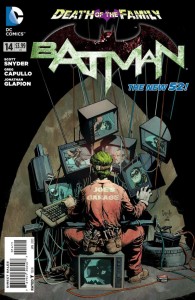 Jonathan Glapion
Jonathan Glapion
No happiness here, but a remarkably gritty, well-told story. It’s damned difficult to take a longstanding character like Batman and make readers care about what happens to him, since readers are so cynical, and know that everything can be reset, but Snyder and company are doing it here — it’s hard to see how anything can be reset easily from the events in this issue (barring another complete reboot), and the suspense level is thus enormous: the Joker has seldom been this insane or downright dangerous, and the stakes have seldom been so high. Kudos to everyone — especially Snyder, who hits every note of menace convincingly, and Capullo, who rises to the occasion with scarily disturbing art; his Joker will linger in your nightmares.
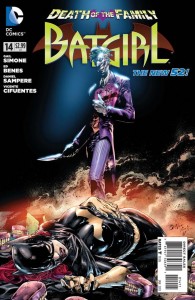 Batgirl #14 — Writer: Gail Simone; Art: Ed Benes and Daniel Sampere; Inks: Vicente Sifuentes and Mark Irwin
Batgirl #14 — Writer: Gail Simone; Art: Ed Benes and Daniel Sampere; Inks: Vicente Sifuentes and Mark Irwin
This doesn’t rise to the level of the main title, Batman, but it comes close — a tribute to Simone’s own skill at scripting convincingly disturbing events (honed in all those gleefully perverse issues of Secret Six). Barbara Gordon fights the Joker, with her mother’s life at stake, and, among other things, we see her determined heroism, the Joker’s warped romantic logic, and a whole new meaning to the phrase “giving someone the finger.” Benes isn’t as shadowy-scary as Capullo, but there’s still something about that pasty-white face, skin held on by wire and eyes burning madly behind it, that’s captivating in any art style.
Fantastic Four #1 — Writer: Matt Fraction; Pencils: Mark Bagley; Inks: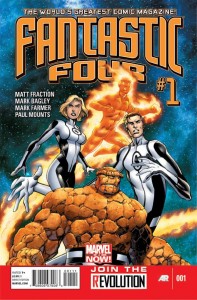 Mark Farmer
Mark Farmer
This is the first of four new Marvel #1s this week. The Marvel Now! creators are facing a harder job than their DC New 52 counterparts, because they don’t have the benefit of a reboot, and its ability to start the characters in whatever new circumstances they want; they have to respect past continuity more, and be more gradual in moving the title in the directions they’d like. With Fantastic Four, there’s the added problem of following an acclaimed run: almost every critic liked Jonathan Hickman’s tenure on this title quite a bit, and the way he ended it on such a series of graceful high notes. Not only that, but just in this century there’ve been great FF arcs by Dwayne McDuffie and Mark Waid, let alone previous decades’ work by John Byrne, Lee and Kirby, etc. That makes Fraction and Bagley’s job all the harder here, but they rise to it with a decent start: a high-stakes problem for Reed to solve, and a clever way to send the cast on a series of interdimensional adventures while keeping the whole family intact. It’s a little disappointing that part of the plot hinges on Reed being something of a dick, because so many recent runs have been about him learning not to be one, and I get the sense that Fraction is slightly regressing both Franklin and Valeria; if so, that’s a shame, because they became such standout characters during Hickman’s time on the book. Still, this is an effective beginning, and offers a good jumping-on point for new readers, plus enough action and promise to bring them back.
 Thor: God of Thunder #1 — Writer: Jason Aaron; Art: Esad Ribic
Thor: God of Thunder #1 — Writer: Jason Aaron; Art: Esad Ribic
Aaron has an easier job than Fraction, since that writer’s previous time on this title was, while not seen as a failure, not considered a huge success either (simple competence is easier to follow than excellence). His opening gambit here is a story weaving together the Thors of three time periods: the young Viking warrior of the 8oos, the character of today, and a much older, Odin-like Thor from a few thousand years in the future. The thread connecting them is a god–killing juggernaut, someone we probably won’t actually see for a few issues; instead, we know he’s a badass by observing his ability to butcher other, slightly-less-badass, characters. Ribic is good at the kind of Conan-like sword-and-sorcery atmosphere that prevails here, and Aaron shows his narrative skill in bouncing between the time periods, and his knack for character by making Thor both recognizable and subtly different in each incarnation. As with FF, this offers new readers a decent jumping-on point, and more than enough reason to read the next issue.
All-New X-Men #1 — Writer: Brian Michael Bendis; Pencils: Stuart 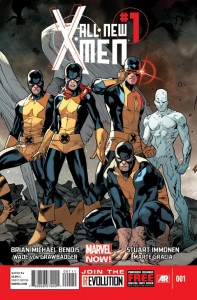 Immonen; Inks: Wade von Grawbadger
Immonen; Inks: Wade von Grawbadger
Bendis has the most high-concept premise here: Henry McCoy, discouraged at the events in AVX and facing a personal deadline to try and fix things, travels back in time to the ’60s version of the X-Men, to get them to travel to the future so young Cyclops and company can confront current Mutant Resistance Fighter Cyclops and get him to stop being such a jerk. One problem is that, as with many Bendis stories, this is decompressed enough that its first issue is mostly set-up; by the end, the “old” X-Men haven’t even traveled to the future yet. Another problem is the whole “Cyclops=jerk” meme, since, as with Civil War, it’s not at all clear that the “winners” are the good guys, or the losers the bad, although the plot requires them to be seen that way. There are also all the problems inherent to this kind of young/old characters time travel story, which have yet to develop but are lurking in the wings. Still, it’s always a pleasure to view Bagley’s fluid, expressive middlebrow art, and you have to admit the plot is a great concept, so watching it spin itself out will be compelling; Bendis, whose strengths are characterization and dialogue, has a lot to work with here, and watching this become either a great ride or a total train wreck will be, either way, entertaining.
 X-Men: Legacy #1 — Writer: Simon Spurrier; Pencils: Tan Eng Huat; Inks: Craig Yeung
X-Men: Legacy #1 — Writer: Simon Spurrier; Pencils: Tan Eng Huat; Inks: Craig Yeung
This is probably the least anticipated of this week’s relaunches, just because the parent book has been seen as a second-tier X-title. In a way, that’s an advantage, because Spurrier has a freer hand to use a quirky, slow build instead of a slam/bang blockbuster first issue. The focus is on Legacy, Professor X’s son, and his attempts to battle his multiply-schizophrenic personalities and harness them. It’s got a lot of indie sensibilities, with Spurrier’s sometimes-poetic dialogue and psychological focus wed to Eng’s expressionistic art (although underneath it all is a fairly standard superhero plot), and while I don’t think it’ll ever be a huge hit it has the potential to become a cult one. Readers who like their Marvel-universe stories a bit off-center should definitely give this a try.
Saga #7 — Writer: Brian K. Vaughan; Art: Fiona Staples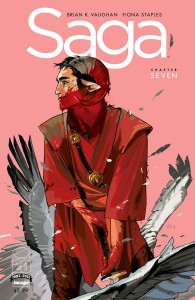
Vaughan’s a smart guy: he knows that the time to start filling in backstory on your main characters is in the second arc, after you’ve hooked readers in the first. Thus, we get to meet Marko’s parents, and find out a little about his childhood, in this issue. As always, the story has a couple of twists and turns, while the art is pretty when it needs to be, and shockingly grotesque when it’s called for (Vaughan likes to give Staples at least one jaw-dropping moment to draw every issue, and you’ll know it when you see it here). The first six issues have been collected into a trade, and this seventh is the perfect time to sample this comic, one of the top candidates for book of the year.
 Mind Mgmt #0 — Creator: Matt Kindt
Mind Mgmt #0 — Creator: Matt Kindt
Here’s another one; although it’s a lot more of an acquired taste, it’s just as adept in its use of comics conventions to tell a completely unconventional story. This “0” issue collects the three digital installments of Mind Mgmt Secret Files that Kindt has published online, each of them taking place before the first issues of the series, and each involving his red-headed reporter, Meru, and earlier stories that she investigated involving his shadowy mental-powers-heavy spy group. For readers who’ve been put off from trying the main book because they think it’s too complicated (although it isn’t), this is an effective introduction to its cool storytelling style, and a bargain at $2.99.
Great Pacific #1 — Writer: Joe Harris; Art: Martin Morazzo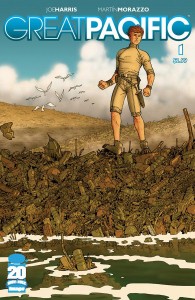
The title refers to one of those great masses of discarded plastic bottles, bags, six-pack connectors and other debris swirled together by ocean currents, to form floating islands of trash out in the Pacific Ocean. That’s the jump-off for a story about a young corporate heir with ecological ideals and a scheme to profit from them; this first issue benefits from likable characters and an intriguing plot, with enough unexpected developments to bring readers back (its oceanic-ecology theme is reminiscent of The Massive, but it’s both lighter and more accessible than that gloomy eco-apocalyptic book), and decent art from Morazzo that’s OK on the faces, but great on the nature stuff — and gorgeous in the coloring, also by Morazzo. In a year of standout creator-owned books by Image, this doesn’t have the gonzo charge of, say, Prophet, but is still a worthy addition to the group.
 Wolverine and the X-Men #20 — Writer: Jason Aaron; Art: Steve Sanders
Wolverine and the X-Men #20 — Writer: Jason Aaron; Art: Steve Sanders
This reads like a fill-in issue; although it’s by Aarons, it has little of his usual charm or weirdness, as Angel goes to Brazil to recruit a new mutant, a girl who’s a wereshark (that sounds like Aarons…), and runs into some competition. That’s about it, though — none of the ongoing subplots get resolved, or even mentioned, and Sanders isn’t the regular artist, and the fact that the next issue ad features the “Frankenstein’s murder circus” plot that was forecast last issue all lead me to call this one a competent but largely-unnecessary delaying tactic. Nice last-page splash of some upcoming Hellfire Club bad guys, though….
The First X-Men #4 (of 5) — Writers: Neal Adams and Christos Gage; 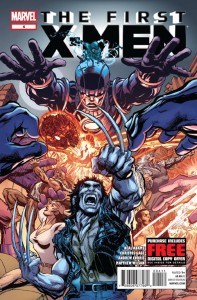 Pencils: Neal Adams; Inks: Andrew Currie
Pencils: Neal Adams; Inks: Andrew Currie
It’s funny how little attention this book has generated — much like Batman: Odyssey, current fans just don’t get excited about Neal Adams art; they have too wide a range of styles and art superstars available to them to care about what’s now a 50-year-old retro look. Too, a book about Logan and Sabertooth recruiting an X-team in the… ’50s? ’60s?… has little suspense, since it’s clear that most of the characters we’ve never heard of are going to die, or fade away. At least with Gage as a co-writer, the words form actual sentences (something that didn’t always happen with Bat: Odd), and that leaves us free to admire Adams’s still-polished art, retro or not (the action scenes have a lot of power, and the character Virus is just the kind of cheerfully-creepy psychopath that Adams was born to draw).
 Avengers Assemble #9 — Writer: Kelly Sue DeConnick; Art: Stefano Caselli
Avengers Assemble #9 — Writer: Kelly Sue DeConnick; Art: Stefano Caselli
Deconnick turns out to be a good replacement for Bendis; she’s got his knack for dialogue, plus a welcome warmth in her characterization. Stark, Banner, Thor and Cap all sound like their movie versions, but after all that’s the goal of this book: to provide an Avengers that’s recognizable to all those people who bought tickets. The plot, involving a race to rescue an Arctic research station that’s gone dark, with rival squads led by Iron Man and the Hulk, is standard but serviceable. The one complaint here is the price: while this book doesn’t founder, it doesn’t soar, either, and as an entry-level book for new readers it really ought to be $2.99, instead of a dollar more.
Locke and Key: Omega #1 (of 7) — Writer: Joe Hill; Art: Gabriel 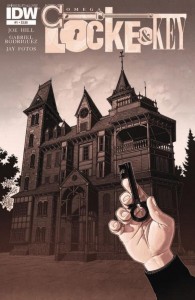 Rodriguez
Rodriguez
This book was Hill’s coming-out party as a comics writer when it debuted almost five years ago; while Stephen King is his father, he writes a lot more like Clive Barker, with an aptitude for showing how normal, psychologically-damaged humans struggle to live their lives even in the face of occult horror. Rodriguez, who’s been there since the start, has art that works a similar spell, walking the tightrope between realism and fantasy; few other artists could have pulled off some of the key-effects he’s been required to sell here. Readers who may have dropped the series over the years may want to come back on now, since this is the first issue of the concluding arc (the name gives it away), and promises to resolve all the questions and character conflicts that have been half a decade in the making.



